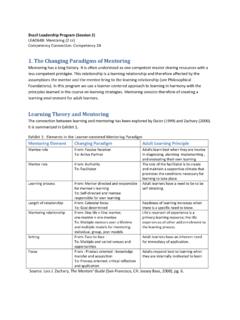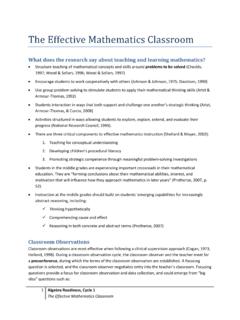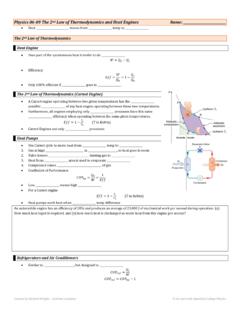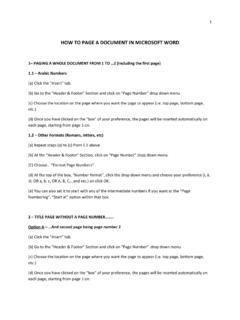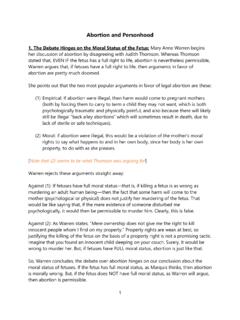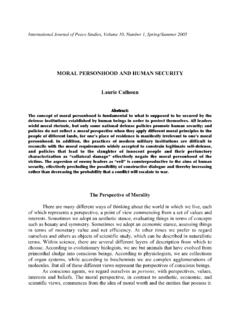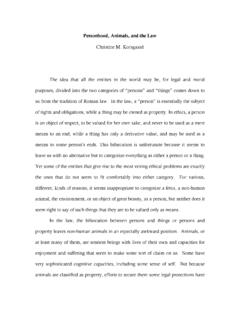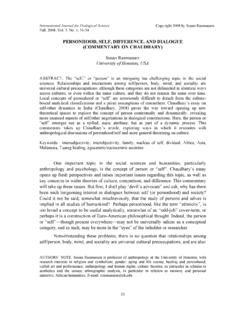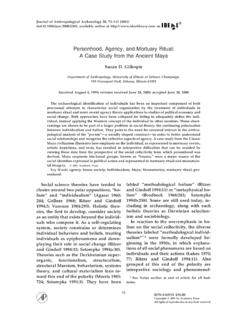Transcription of THST 639 DOCTRINE OF THE HOLY SPIRIT - Andrews …
1 thst 639 DOCTRINE OF THE holy SPIRIT November 11-15, 2012 Atlantic Union Conference Professor Eric Del Valle thst 639 DOCTRINE OF THE holy SPIRIT November 11-15, 2012 GENERAL CLASS INFORMATION Class acronym: thst 639 Class name: DOCTRINE of the holy SPIRIT Semester & year: Fall 2012 Class loc ation : Southern New England Conference Office Class time/day: 7- 9 pm Sunday, Nov. 11 8- 5 Monday Thursday, Nov. 12-15 Credits offered: 3 INSTRUCTOR CONTACT DETAILS Instructor : Eric Del Valle Telephone: 939-202-0635 Email: BULLETIN CLASS DESCRIPTION The pe rson and work of t he Hol y SPIRIT i n the plan of r edemption and the divine economy. CLASS OBJECTIVES The Academic Objectives To encourage and provide opportunity to seminary students to think for themselves and to reason for themselves prayerfully about the subject of the holy SPIRIT , and not to be mere reflectors of the thoughts of others on this topic; and to increase graduate student interest in this crucially important topic.
2 To provide helpful factual knowledge about selected aspects of the person and work of the holy SPIRIT in the plan of redemption and the divine economy as viewed from biblical, theological, and philosophical perspectives. This information will help the seminary student to understand and evaluate fundamental theories with respect to the DOCTRINE of the holy SPIRIT . To integrate the DOCTRINE of the holy SPIRIT into the whole of Christian life and into other Christian concepts. The Practical Objectives To relate the course material to real-life situations. This objective means that we will apply the course material to the daily work of the minister in the local church setting. To assist the seminary student in forging practical tools and materials which can be immediately used and applied in a local church setting for the enrichment and up-building of the members, and for winning new individuals to Jesus Christ.
3 The Spiritual Objectives The spiritual objective of this class is that by the grace of God we might become ministers and teachers filled with the holy SPIRIT . May God richly bless you and the instructor as we explore this inexhaustible subject together! COURSE CONTENTS 1. Introduction 2. Controversies on the holy SPIRIT 3. Foundations a. Gr. Allos parakletos (trans. another comforter ). 4. The Trinity in Biblical Revelation a. The Trinity in the Old Testament b. The Trinity in the New Testament 5. Jesus as God a. The Testimony of Matthew b. The Testimony of John i. The Gospel ii. Revelation 6. The Trinity in Catholic Theology 7. Adventism and Trinitarian Theology 8. Trinitarian Thought in Ellen G. White 9. Preliminary Conclusions HOW MUCH TOTAL TIME INVESTMENT FOR THIS CLASS?
4 Advanced theological education is no cake-walk , nor is it intended to wear out the saints . Designed to immerse the learner in deep theological study and introspective reflection, seminary course expectation is to challenge the student by examining his/her own premises against the study, research and inspiration of biblical scholarship. This will take intentionality and time on your part. Course load is guided by the expectation that students will spend a total of 45 hours of course exposure to earn 1 hour of academic credit. That translates into 90 hours invested for a 2-credit class, and 135 hours for a 3-credit course. Students are advised to spend their time accordingly to meet course requirements and deadlines. Following is a rule of thumb to help guide your reading, research, and writing for Seminary courses: Average reading speed 15-20 pages/hr.
5 Average writing speed 3 Exam preparation 4- 8 hours Based on these averages, requirements for this class will take the average student the following: Required reading (436) 30 hrs. 12-page reading reports 36 hrs. Class presentation 20 hrs. Class Notes/Reflection 20 hrs. Sermon outline 10hrs Hours in class 30 hrs. -------------------- Total Hours for class 146 TEXTBOOK AND RECOMMENDED READING Required Books 1. Ron Clouzet, Adventism s Greatest Need, Nampa, ID: Pacific Press, 2011. 224 pages. Articles 1. Edwin Reynolds, The Trinity in the Book of Revelation, Journal of the Adventist Theological Society 17, no. 1 (2006): 55-72. 18 pages. 2. Gerhard Pfandl, The DOCTRINE of the Trinity Among Seventh-day Adventists, Journal of the Adventist Theological Society 17, no.
6 1 (2006): 160-179. 20 pages. 3. Gerhard Pfandl, The Trinity in Scriptures, Journal of the Adventist Theological Society 14, no. 2 (Fall 2003): 80-94. 15 pages. 4. Jerry Moon, The Quest for a Biblical Trinity: Ellen White s Heavenly Trio Compared to the Traditional DOCTRINE , Journal of the Adventist Theological Society 17, no. 1 (2006): 140-159. 20 pages. 5. Merlin D. Burt, History of the Seventh-Day Adventist Views on the Trinity, Journal of the Adventist Theological Society 17, no. 1 (2006): 125-139. 15 pages. 6. Norman R. Gulley, Trinity in the Old Testament, Journal of the Adventist Theological Society 17, no. 1 (2006): 80-97. 18 pages. Recommended 1. Concordia Theological Quarterly 67, no. 3-4 (July/October 2003). 2. Denis Fortin, God, Trinity, and Adventism: An Introduction to the Issues, Journal of the Adventist Theological Society 17, no.
7 1 (2006): 4-10. 3. Norman R. Gulley, A One-sided Trinity in Theology: It s Continuing Impact, Journal of the Adventist Theological Society 6, no. 1-2 (2005): 43 74. 4. Ron E. M. Clouzet, The Personhood of the holy SPIRIT and Why it Matters, Journal of the Adventist Theological Society 17, no. 1 (2006): 11-32. 22 pages 5. Woodrow W. Whidden, Trinitarian Evidence in the Apocalypse, Journal of the Adventist Theological Society 11, no. 1-2 (2000): 248-260. GRADING CRITERIA AND COURSE ASSESMENT ITEMS Course Requirements Pre-course assignments 1. Reading Reports. Students must complete the required readings listed below, and submit a reading report for each reading assignment in accordance with the instructions given below in the section Specifications for reading reports. Students must submit their pre-campus readings the first day of class.
8 O Edwin Reynolds, The Trinity in the Book of Revelation, Journal of the Adventist Theological Society 17, no. 1 (2006): 55-72. 18 pages. Available at the ATS website: o Gerhard Pfandl, The DOCTRINE of the Trinity Among Seventh-day Adventists, Journal of the Adventist Theological Society 17, no. 1 (2006): 160-179. 20 pages. Available at the ATS website: o Gerhard Pfandl, The Trinity in Scriptures, Journal of the Adventist Theological Society 14, no. 2 (Fall 2003): 80-94. 15 pages. Available at the ATS website: o Jerry Moon, The Quest for a Biblical Trinity: Ellen White s Heavenly Trio Compared to the Traditional DOCTRINE , Journal of the Adventist Theological Society 17, no. 1 (2006): 140-159. 20 pages. Available at the ATS website: o Merlin D. Burt, History of the Seventh-Day Adventist Views on the Trinity, Journal of the Adventist Theological Society 17, no.
9 1 (2006): 125-139. 15 pages. Available at the ATS website: o Norman R. Gulley, Trinity in the Old Testament, Journal of the Adventist Theological Society 17, no. 1 (2006): 80-97. 18 pages. Available at the ATS website: DURING- COURSE ACTIVITIES AND ASSIGNMENTS 1. Class attendance. Attendance to all class sessions is required. The Andrews University Bulletin states that when absences exceed 10% of the total course time, you may receive a failing grade. For this intensive class, being absent from more than one learning block may jeopardize your final grade, as each class day takes over 20% of the total class time and is equivalent to over 3 weeks in a regular semester. More importantly, your involvement and contributions are crucial to the learning process and will help enrich class dynamics, relationships and individual growth.
10 2. Presentations. Choose a topic and prepare a presentation for the class. 35 Minutes of presentation and 25 minutes of questions and answers. Students should be capable of answering the questions raised by their audience if they relate to the topic exposed. Topics should be consulted with the professor. Students should spent around 20 hours of reading in preparation for the presentation. Topics will be presented in the last two formal meeting of the class. 3. Final examination. The final examination is scheduled for the last afternoon (Thursday) and will cover Mackie s book and all class lectures. You must be present for the exam at the scheduled time. The only exceptions for missing the prescribed date will be extreme illness or death. POST- COURSE ASSIGNMENTS 1. Class Notes/Reflection.

